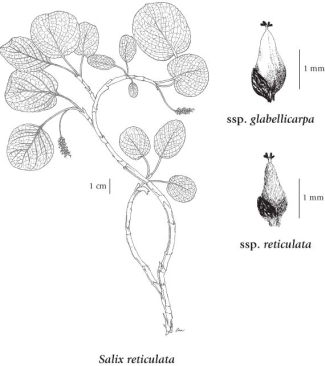Salix reticulata L.
net-veined willow (netleaf willow; net-leaved willow)
Salicaceae (Willow family)
Introduction to Vascular Plants
net-veined willow (netleaf willow; net-leaved willow)
Salicaceae (Willow family)
Introduction to Vascular Plants
SUBTAXA PRESENT IN BC
Introduction
This widespread circumpolar species is found in North American and Eurasia. Argus et al. (2012), in Flora North America (2012), indicate that one subspecies has been identified: "A population of Salix reticulata on the Queen Charlotte Islands, with consistently glabrous ovaries, was named subsp. glabellicarpa. Some southeastern Alaska populations have plants with glabrous, partially hairy, and completely short-silky ovaries growing together. The possibility that subsp. glabellicarpa may be a hybrid or a simple mutation needs study."
|
Species Information
General:
Dwarf shrubs, 3-15 cm tall, spreading by layering; branches trailing, flexible at base; twigs yellow- to red-brown, smooth.
Leaves:
Alternate, simple, broadly oblong to broadly elliptic or nearly circular, 1-6.5 cm long, 0.8-5 cm wide, lower surface glaucous, silky to nearly smooth, hairs white, upper surface shiny or highly glossy and deeply net-veined, smooth, entire or obscurely toothed, bases rounded or heart-shaped, tips rounded; leaf stalks with or without glandular dots at top; stipules rudimentary.
Flowers:
Unisexual, lacking sepals and petals, borne in catkins which flower as leaves emerge, the catkins stout, on leafy twigs; floral bracts pale; stamens 2; ovaries 1, hairy or smooth; styles 0.2-0.4 mm long.
Fruits:
Capsules which split open to release the seeds, each of which is surrounded by a tuft of hairs; stalks 0-0.8 mm long.
Notes:
In this species the vegetative twigs almost always terminate in a catkin.
Illustration

If more than one illustration is available for a species (e.g., separate illustrations were provided for two subspecies) then links to the separate images will be provided below. Note that individual subspecies or varietal illustrations are not always available.
Illustration Source: The Illustrated Flora of British Columbia
USDA Species Characteristics
Flower Colour:
Purple
Blooming Period:
Early Summer
Fruit/Seed characteristics:
Colour: Red
Present over the
Source: The USDA
Ecology
Ecological Framework for Salix reticulata
The table below shows the species-specific information calculated from
original data (BEC database) provided by the BC Ministry of Forests and Range.
(Updated August, 2013)
The table below shows the species-specific information calculated from
original data (BEC database) provided by the BC Ministry of Forests and Range.
(Updated August, 2013)
| Site Information |
Value / Class |
||
|
Avg |
Min |
Max |
|
| Elevation
(metres) |
1644 | 7 | 3000 |
| Slope
Gradient (%) |
21 | 0 | 300 |
|
Aspect (degrees) |
235 | 0 | 360 |
| Soil
Moisture Regime (SMR) [0 - very xeric; 4 - mesic; 8 - hydric] |
3 | 0 | 8 |
| Modal
Nutrient Regime
Class |
C | ||
| #
of field plots species was recorded in: |
654 | ||
| Modal
BEC Zone Class |
BAFA | ||
|
All BEC Zones (# of stations/zone) species was recorded in |
AT(8), BAFA(332), BWBS(12), ESSF(108), IMA(14), MH(2), SBS(1), SWB(144) | ||
|
Source:
Klinkenberg 2013
|
|||